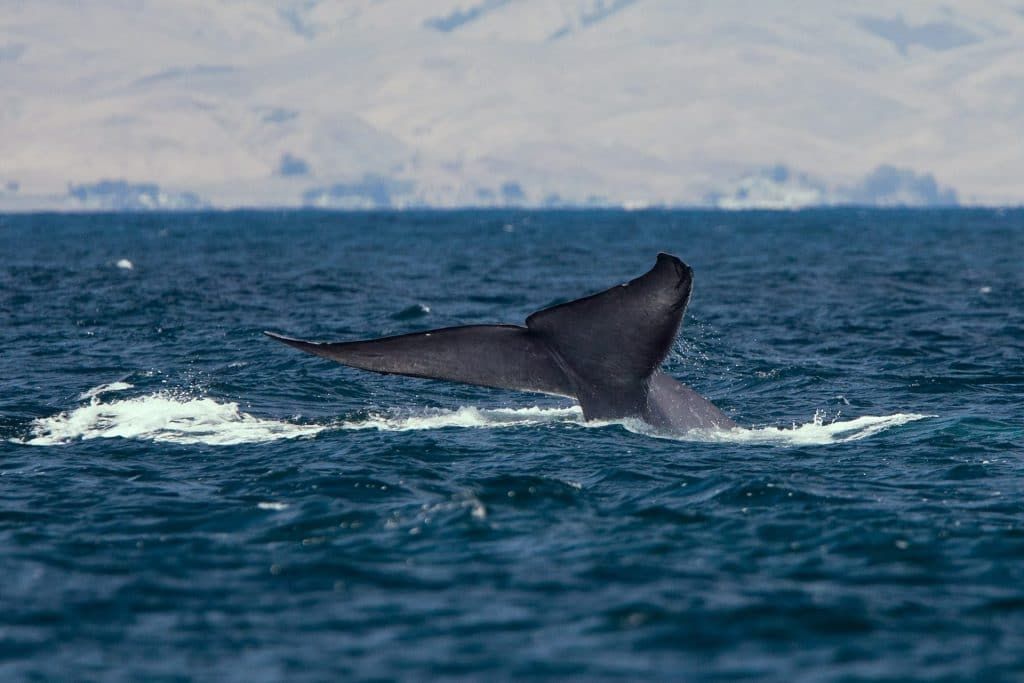Nuclear bomb detectors reveal hidden blue whale population
By Susan D’Agostino | October 18, 2021
 A rare spotting of a blue whale tail fluke. Credit: Mike Baird. Accessed via Wikimedia Commons. CC BY 2.0.
A rare spotting of a blue whale tail fluke. Credit: Mike Baird. Accessed via Wikimedia Commons. CC BY 2.0.
Blue whales may be the largest animals on the planet, but they are difficult to spot. The commercial whaling industry in the 20th century drove them to the brink of extinction, and today they are listed as endangered under the Endangered Species Act. An individual blue whale may weigh as much as 33 elephants, but many go unnoticed as their numbers are few, and they live mostly solitary lives spread across all oceans except the Arctic. Yet earlier this year, a team of scientists reported finding a new population of pygmy blue whales right in the middle of the equatorial Indian Ocean, thanks to nuclear-test-detection equipment.
“The discovery wouldn’t have been possible otherwise,” Emmanuelle Leroy said, referring to the network of underwater microphones that “listens” for soundwaves indicative of underwater explosions. Leroy is a bioacoustician—a scientist who studies how animals create and perceive sounds—and lead author of the study reporting on the pygmy blue whale discovery. (Pygmy blue whales are small only when compared with other blue whales; at 90 tons, they can weigh as much as 15 elephants, assuming an elephant weighs approximately 6 tons.) Now that scientists are aware of this new population of blue whales, they can work to protect these vulnerable giants from threats such as vessel strikes, entanglement in fishing gear, ocean noise, and climate change.
“I think it’s pretty cool that the same system that keeps the world safe from nuclear bombs allows us to find new whale populations, which long-term can help us study the health of the marine environment,” Tracey Rogers, a marine ecologist and senior author on the study, said.
The nuclear-test-detection system. The underwater microphones are part of the International Monitoring System that ensures “no nuclear explosion goes undetected.” The system is a (nearly finished) global network of 170 seismic stations, 80 radionuclide stations, 60 infrasound stations, and 11 hydroacoustic stations spread over 89 countries around the globe. Data from the network is collected at the Comprehensive Nuclear-Test-Ban Treaty Organization’s headquarters in Vienna, where it is made available for civic and scientific uses. Japan, for example, uses the data to obtain real-time information about underwater earthquakes that precede tsunamis, which allows for early warnings that save lives.
To hear the songs of the new blue whale population, Leroy and her team pored over nearly two decades’ worth of underwater ocean soundscape recordings from six different recording sites in the monitoring system.
“At first I noticed a lot of horizontal lines on the spectrogram,” Leroy said. “These lines at particular frequencies reflect a strong signal, so there was a lot of energy there.”
The songs varied among the sites by season, which suggested that the whales migrate in the central Indian Ocean, reaching as far east as the north of Western Australia and possibly as far north as Sri Lanka. The Indian Ocean, it turns out, is home to a greater variety of pygmy blue whales than previously known.
What do the whale songs sound like? The rumblings heard on the recordings shared low-frequencies, rhythms, and structures characteristic of large whales. (See whale song playlist above.) The audio patterns repeated and were consistent over the years of data, leading the researchers to believe that the animals were blue whales rather than, for example, humpback whales.
“Humpback whales are like jazz singers. They change their songs all the time,” Rogers said. “Blue whales, on the other hand, are more traditional. They sing very structured, simple songs.”
Still, the researchers knew that different subspecies of blue whales, including those in the Indian Ocean, sing different songs. Though the vocalizations sounded like those of blue whales in general, they differed from any known blue whale population.
“The whale songs were a huge part of the acoustic soundscape over 18-20 years,” Leroy said. “After going through the data, I thought, ‘Wow, there are a huge amount of them, not just a couple!’ That’s why we thought it was a different population.”
The scientists called the new pygmy blue whale population “Chagos,” after the Indian Ocean archipelago where they were discovered.
No one has yet set eyes on Chagos whales, though that is unsurprising. Blue whale populations are often identified by sound rather than sight due to their reclusive nature. Sound travels far in water, which makes it well-suited to the task of identification. That whale songs can be louder than jet engines and may be heard underwater up to 1,000 miles away helps.
Indeed, those who designed the International Monitoring System took full advantage of water’s sound propagation properties. That is, the system required far fewer hydroacoustic stations than seismic, radionuclide, and infrasound stations. Best of all, the acoustic data from the system is available on short notice.
“You don’t have to wait. It’s kind of magic,” Leroy said, contrasting the experience with earlier research in which acoustic data she needed from a different system—one unrelated to detecting nuclear tests—required waiting a year.
What comes after a new whale population discovery? Though the data provided information about the Chagos’ existence and movements, Leroy and her team have many unanswered questions. For example: How many of these whales exist? Are their songs innate, or do they learn them from a parent? What, precisely, are their migration routes? And perhaps most important: How can humans protect these vulnerable mammals from modern threats?
Without temporary protection zones in which mariners are asked to slow down or avoid migration routes, boats may collide with and kill or injure whales or produce noise that disrupts their feeding, reproduction, and social behavior. The International Whaling Commission, which oversees a Global Whale Entanglement Response Network, also needs up-to-date information about whale habitats in its work to free whales that become entangled in fishing nets. Scientists and environmentalists also use information on whale habitats in their advocacy.
Perhaps it is unsurprising that the International Monitoring System, which was designed to protect all living beings on Earth, has already helped the newly discovered Chagos blue whales. As Leroy said, “Discovering a new population is the first step to protecting it.”
Together, we make the world safer.
The Bulletin elevates expert voices above the noise. But as an independent nonprofit organization, our operations depend on the support of readers like you. Help us continue to deliver quality journalism that holds leaders accountable. Your support of our work at any level is important. In return, we promise our coverage will be understandable, influential, vigilant, solution-oriented, and fair-minded. Together we can make a difference.














